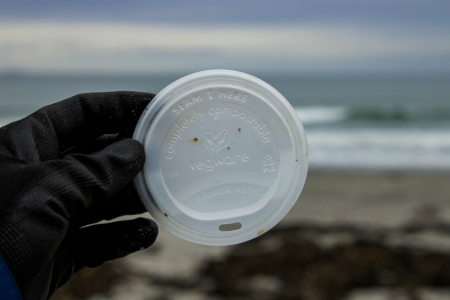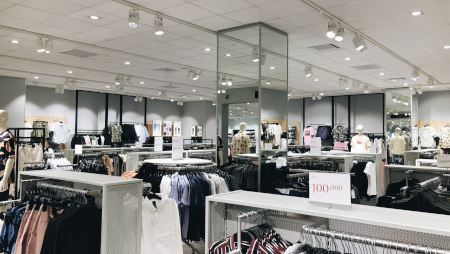Greenwashing is a term that’s becoming increasingly more familiar to many of us, but what does it actually mean? It’s important that we understand how and when businesses and brands are guilty of this, but just how to spot the difference between genuine focus on environmental impact and shallow marketing tactics can be difficult if you aren’t familiar with it.
What is greenwashing?

Greenwashing is the action to mislead the public or media by falsely representing a person, a company, or a product as being environmentally responsible, according to the Oxford English Dictionary. In short, it’s when we as consumers are led to believe that a product or service is better for the environment than it really is.
Often, greenwashing is done subtly by the use of nebulous terms, such as ’sustainable’ or ‘green’. These concepts are used purposely due to a lack of global standards, legislation, and regulation around what constitutes an eco-friendly product. This insinuation that a product or service is environmentally or ethically superior influences purchasing behaviour.
As ethical and environmental issues become more important to many consumers, brands are ensuring they do all they can to appeal to this growing market, often not through real action and changing behaviour, but clever marketing.
How did the term ‘greenwashing’ come about?
Greenwashing is not a new phrase; the term was coined in 1986 by environmentalist Jay Westervelt in an essay he wrote which exemplified how an American hotel’s marketing campaign deliberately deceived its patrons. Throughout the 1980s and 1990s, it was frequently used to describe a deliberate strategy that oil, automotive, and chemical companies used to mislead consumers. But in the last 20 years, the term has become synonymous with the fashion industry and even more recently with the advent of ESG, the finance sector.
Greenwashing as a marketing strategy

In short, companies use greenwashing as a marketing strategy to increase sales. As society becomes more aware of the need to consume more consciously, the ability to influence shoppers who are more environmentally-minded increases. By appealing to those consumers, through insincere or inaccurate claims, some businesses (often those with vast customer reach) can sway or convert shoppers to buy their product or services because of their alleged care for the environment. As a result, they gain a competitive advantage over their rivals and increase market share or sales.

The use of natural colours, paper packaging, and the inclusion of animals or nature are commonly used as deliberate marketing ploy to give the impression that a product is more environmentally responsible than it actually is.
This strategy plays on the lack of clarity and regulation globally, and frequently the marketing claims leave a lot of room for interpretation. Words and images are purposely vague, and at times misleading, to target buyers who just want to ‘do the right thing’.
While greenwashing is not illegal, many countries are stepping up regulation to prevent business from making false or misleading claims. In France legislation has recently been passed to hold companies accountable, with penalties that include fines and a public correction. In an effort to further reduce greenwashing by companies, the European Commission have initiated a consultation, proposing the introduction of standard measurables to substantiate a company’s environmental claim. The aim is to ensure they are reliable, comparable, and verifiable across the EU, these measurables would be applicable for companies exporting from Hong Kong to the EU.
In Hong Kong, greenwashing is often discussed in the context of financial services. As ESG investing grows, so does the risk of greenwashing in this sector. Alexander Chan, Head of ESG Client Strategy, Asia Pacific at Invesco says, “Greenwashing activity over time could result in the loss of investor confidence in ESG investing and more importantly become a distraction to making actual ESG and climate progress.”
In order to give this a legal framework, standards and regulation is needed alongside international collaboration.
Examples of greenwashing companies
Greenwashing is prevalent in all sectors, from fashion and beauty to F&B and finance. The aviation industry hit the headlines in Hong Kong in early 2022 for alleged greenwashing over airport investment. Reclaim Finance, a Paris based climate campaigner has criticised the issuance of a green bond for this project, saying it raised “serious climate and biodiversity-related risks.”
Another example of companies greenwashing is McDonald’s, which was heavily criticised in 2019 when they replaced single-use plastic straws with paper ones in a bid to appear more environmentally responsible. The reality was that the straws were non-recyclable, they had simply moved from one non-sustainable practice to another, hoping that the use of paper would appease those wanting to reduce landfill.

Fashion, especially fast fashion, is notorious for greenwashing. A 2021 report from the Changing Markets Foundation looked at clothing from major high-street fashion brands to check the truthfulness of their sustainability claims. They found that 60% of these claims were misleading. H&M were found to be the worst offender with a shocking 96% of their claims not holding up.
How companies can actually be sustainable?

There is constant debate in apparel about what is sustainable, but the reality is complex and a whole range of factors make up the overall environment and social impact of production. From materials, to where and how it is produced, to the logistics and transportation. Unless a business is founded on a sustainable strategy and culture, it takes a lot of time and money to transition to a sustainable business. The bigger the company, the harder the transition becomes, with buy-in from all stakeholders and board being critical for success.
In beauty, the narrative is often that products are ‘green’ or ‘clean’. This unsubstantiated terminology gets people to buy into brands whose messaging is greener than their product. ‘No nasties’ is a great example of words that mean nothing, as is ‘chemical-free’.
Do we even care that we’re being greenwashed?
Many consumers do care that we’re being greenwashed, according to Brand Consultant of Side by Side, Charlotte Wilkinson says: “The more sustainably educated consumers become, the more discerning they become. Food, Fast Moving Consumer Goods and Clothing are the sectors where consumers are most sensitive to shopping with a sustainable mindset.”
Generally speaking, when we know we are being fooled, we become annoyed by that brand or company and we are less likely to shop with them again. The issue is often knowing what’s really green and what’s greenwashed. Many brands, at all spectrums of the market, have been accused of deliberately using vague or exaggerated language. Misinformation is rife and unfortunately, it comes down to you and me to delve behind the label and ask questions in order to see the full picture. Sadly, this takes time, effort, and resources that many of us just don’t have on a daily basis. As a result, consumers are left confused, frustrated, and vulnerable to misinformation.

With a retail career spanning twenty years, Sheryl has worked for some of the biggest brands across Buyers and Sourcing. Her increasing concern about the negative impact of the industry led her to write her debut book, Sustainably Stylish – A guide to curating a guilt-free wardrobe. Sheryl graduated from Hong Kong University with an Executive Certificate in Corporate Social Responsibility and is passionate about making retail and life, in general, more sustainable.
Her everyday musings can be found on Instagram @makemywardrobework or on her website www.makemywardrobework.com.
Disclaimer: The opinions expressed in this publication are those of the authors and do not necessarily represent the views of The HK HUB.
Header image credits: tanaonte via Canva




